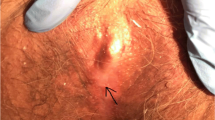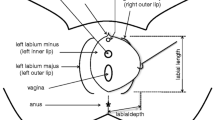Abstract
Labial fusion is a common condition in prepubertal girls due to hypoestrogenism or in postmenopausal women with lichen sclerosis. It can also be seen as a result of chronic inflammation, urinary tract infection, and sexual abuse or following female genital mutilation. We present a rare case of almost complete labial fusion in a woman of the reproductive age group without any identifiable cause.
Similar content being viewed by others
Case report
A 40-year-old woman attended the gynaecological out-patient department with a history of increasing difficulty in passing urine over the last six months. She had no significant past medical or surgical history. She had regular menstrual cycles. She had never been sexually active.
On examination, she had normal secondary sexual characteristics. Abdominal examination was normal. Examination of the genital area showed almost complete fusion of the labia minora with a pin-hole opening (Fig. 1). There was no evidence of lichen sclerosis or any other chronic skin condition. An ultrasound scan of the pelvis showed normal uterus, ovaries, cervix and normal vaginal length.
The labial fusion was divided under general anaesthetic (Fig. 2). She was discharged with vaginal dilators and oestrogen cream for local application. At six-weeks check-up, the labia remained separated.
Discussion
Labial fusion is commonly seen in prepubertal girls, typically between the ages of three months and six years. About 1 to 2% of females in this age group may have varying degrees of labial adhesions. The condition is often asymptomatic, though, occasionally, it can give rise to problems in voiding urine. It often resolves spontaneously with the onset of puberty. Topical oestrogens can also be used to separate the fused labia. Differential diagnoses include imperforate hymen and other vaginal abnormalities.
Labial fusion is also commonly seen in postmenopausal women with lichen sclerosis. Other causes include sexual abuse, female genital mutilation and trauma [1]. Labial fusion has also been reported after normal vaginal delivery [2].
However, labial fusion in the reproductive age group without any evidence of hypoestrogenism or chronic skin condition is extremely rare [3].
We reported one such case in this paper. The main presentation was a voiding problem. There was no history of trauma or sexual abuse to account for the fused labia. The woman had regular menstrual cycles. There was no evidence of hypoestrogenism on clinical examination. We did not biopsy the vulval skin because, on clinical examination, the skin looked entirely normal.
We separated the labia surgically under general anaesthetic. Examination of the vulva after the separation showed a normal cervix, vagina and urethral opening. The clitoris, however, looked flatter than normal. The labia remained separated following surgery and the application of topical oestrogens.
References
Kumar RK, Sonika A, Charu C, Sunesh K, Neena M (2006) Labial adhesions in pubertal girls. Arch Gynecol Obstet 273(4):243–245
Sharma B, Arora R, Preston J (2005) Postpartum labial adhesions following normal vaginal delivery. J Obstet Gynaecol 25(2):215
Seehusen DA, Earwood JS (2007) Postpartum labial adhesions. J Am Board Fam Med 20(4):408–410
Author information
Authors and Affiliations
Corresponding author
Rights and permissions
About this article
Cite this article
Putran, J., Khaled, M.A. & Almusawa, S. Labial fusion in the reproductive age group: a rare presentation. Gynecol Surg 5, 313–314 (2008). https://doi.org/10.1007/s10397-008-0378-x
Received:
Accepted:
Published:
Issue Date:
DOI: https://doi.org/10.1007/s10397-008-0378-x






